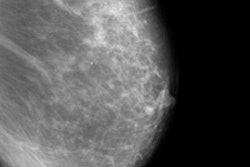
Using digital breast tomosynthesis (DBT) in combination with full-field digital mammography (FFDM) delivers a "substantial" improvement in specificity and a small improvement in sensitivity, according to researchers from Cambridge, U.K.
It is well known that with a standard mammogram, overlapping structures can obscure some cancers or make normal tissue appear abnormal. This is a particular problem in dense breasts. One of the promises of tomosynthesis is that it improves visibility, especially for hard-to-see, small lesions.
In a packed session at the recent ECR 2014 in Vienna, Dr. Fiona Gilbert, a radiology professor at the University of Cambridge, discussed whether 2D FFDM images with DBT have improved sensitivity and specificity compared with 2D FFDM alone. She and her colleagues also looked at whether synthetic 2D images -- the composite image that's produced from the 3D acquisition -- used with tomosynthesis has improved sensitivity and specificity compared with 2D.
 There may be an opportunity for further improvements in synthetic 2D algorithms, Dr. Fiona Gilbert told ECR 2014 delegates.
There may be an opportunity for further improvements in synthetic 2D algorithms, Dr. Fiona Gilbert told ECR 2014 delegates.For the Comparison of Tomosynthesis With Digital Mammography in the U.K. National Health Service Breast Screening Programme (TOMMY) trial, women who were recalled following screening consented to have additional DBT imaging at the time of their assessment.
Data were collected prospectively for each case. Histopathology from core biopsy or surgical excision was used as the gold standard to confirm cancer. The sensitivity and specificity of each of the different imaging combinations were compared in a retrospective reading study. Each case was read three ways -- 2D FFDM alone, 2D FFDM with DBT, and synthetic 2D with DBT -- by three different experienced screening readers who were not from the site where the case originated.
More than 8,869 women age 50 and older were recruited, and 7,060 cases were included in the reading set after exclusions. There were 1,000 cancer cases, and 33% of women fell into the BI-RADS 1 category, 38% in BI-RADS 2, 24% in BI-RADS 3, and 5% in BI-RADS 4. Most cancer cases were invasive ductal carcinoma (788), but 203 were ductal carcinoma in situ (DCIS).
Similar to the screening population, 316 cases had lesions smaller than 10 mm in size.
The sensitivities and specificities for all three arms of the study are shown below.
| Arm | Sensitivity | Specificity |
| 2D FFDM alone | 87% | 58% |
| 2D FFDM with DBT | 89% | 69% |
| Synthetic 2D with DBT | 88% | 71% |
"In the tomosynthesis arms, there was a significant improvement in specificity compared with the 2D arm," Gilbert said. "There was no difference in sensitivity between 2D alone and synthetic 2D with tomosynthesis. We found only a very small improvement in the sensitivity; borderline significance between standard 2D and conventional 2D being used with tomosynthesis."
The researchers also conducted a subanalysis that looked at cancer cases of lesions smaller than 10 mm in size. They found no difference in sensitivity across the three arms. However, for tumors between 11 mm and 20 mm, they found significant improvement in both 2D FFDM plus tomosynthesis and synthetic 2D using tomosynthesis.
Regarding density, the researchers found significant improvement in sensitivity using tomosynthesis with 2D images compared with 2D alone: 93% versus 86%. "But we did not find this when we were using composite 2D synthetic images with tomosynthesis," Gilbert added.
The improvement in specificity was seen across all ages, breast densities, and radiological features, she emphasized. There was borderline improvement in the sensitivity overall, but there was improved sensitivity for 2D FFDM with DBT for the higher density BI-RADS 3 and 4 categories in particular.
"We think there may be an opportunity for further improvements in synthetic 2D algorithms, which may allow us to look again at replacing 2D FFDM with tomosynthesis," Gilbert concluded.



















